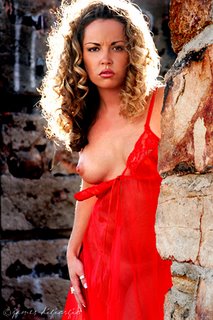 Now that I'm a former studio owner, I've thought about how having a studio affected my equipment acquisition decisions, especially as it pertains to lighting and grip gear.
Now that I'm a former studio owner, I've thought about how having a studio affected my equipment acquisition decisions, especially as it pertains to lighting and grip gear. Throughout the time I had my studio, about 2 years, I earned approximately the same income on location shoots as I did in the studio. I'll admit, I never worked much at marketing the studio as a rental space. Mostly, because I was concerned about strangers messing with my stuff. The biggest problem I had was storage space-- there simply wasn't enough of it. All my lighting, grip, props, set-pieces, and wardrobe were kept in the open. Certainly, it wouldn't have been all that easy for someone to walk out with a monolight or a couple of C-stands but it wasn't out of the realm of possibilities either.
Space is an even larger issue when I'm booked for location shoots. My vehicle is not a truck, van, or SUV; it's a 4-door sedan. That means space is at an even greater premium when I'm packing up to go shoot.
Some of my gear makes sense for using both in a studio and on location. Monolights, as opposed to packs and heads, are a good example: They're very portable, they're powerful yet adjustable light sources, and, when necessary, they can be powered by battery packs. Besides, I wouldn't want to schlep around heavy power packs when shooting on location. IMO, packs-and-heads are old school. And while I consider myself something of an old school shooter who subscribes to many old school techniques and approaches to shooting pretty girls, it seems to me that applying those techniques doesn't preclude using the latest technologies. The switch from film to digital as the dominant medium used amongst shooters is a good example. My advice? If you're contemplating purchasing lighting gear, go with monolights. Power isn't the only consideration when buying lighting equipment. And it's often less important when shooting glamour and portraits. Put portability high on your list of importance.
 Modifiers are another consideration. I love using my Mola beauty dish. But it isn't very portable. It can't be folded-up and its large, bell-shaped body isn't very practical when loading up a car with gear. Softboxes and umbrellas make more sense. My favorite mainlight modifier, after the Mola dish, is my 5' Octodome. It provides soft, wrap-around lighting characteristics and it easily sets-up, folds-up, and packs-up.
Modifiers are another consideration. I love using my Mola beauty dish. But it isn't very portable. It can't be folded-up and its large, bell-shaped body isn't very practical when loading up a car with gear. Softboxes and umbrellas make more sense. My favorite mainlight modifier, after the Mola dish, is my 5' Octodome. It provides soft, wrap-around lighting characteristics and it easily sets-up, folds-up, and packs-up.I guess what I'm saying is that, even if you have a studio, you should be thinking about how easy is is for you to pack up your gear and head out to a location without sacrificing what gear you'll need to get the job done. I suppose if money ain't an object, you could maintain two, distinct, sets of gear: One set for the studio and one for when you're on-the-go. In my case, however, money is an issue so I'm most-often looking for redundancy in terms of useable applications for my gear.
BTW, my favorite "Case for Portability" is the Pelican case. If you're not acquainted with Pelican's products, check out Pelican's website for info.
The shot-on-location images accompanying this update are of my good friend Kori Rae. They were captured near El Mirage Dry Lake, near Victorville, California, at the ruins of an old stone house. I didn't schlep much gear up to El Mirage, just my camera, a light meter, a few reflectors, and Kori. (Oh yeah. My pal Rick, another shooter, was also there. Hey! Someone's gotta hold the reflector!)

No comments:
Post a Comment